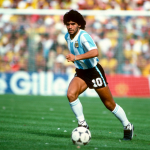
Cameroon's history of football kit controversies
Whether it's offending FIFA or being taken to court by their sponsors, Cameroon is second to none
November 24th, 2022
For some international teams, the strip they wear is like a badge of honour, recognised around the world as a marker of class and quality. Brazil are unmistakable in their yellow and green shirts, blue shorts and white socks. Made famous by the likes of Garrincha, Pele and Carlos Alberto before Ronaldo and Ronaldinho had their turn in it, Brazil’s kit carries a weight of expectation. After all, they didn’t earn those five stars above the crest for nothing. Or take the Netherlands in their standout Oranje kits. Johan Cruyff and total football helped build the reputation, as did the colour’s rarity in international football.
Then there is Cameroon. Their colours of green, red and yellow are also worn by a number of other African nations, so they don’t enjoy the same level of immediate recognition as the Dutch, or Brazil. Five African Cup of Nations titles are not to be sniffed at, but on the biggest stage it was Roger Milla’s goalscoring and corner flag dancing at Italia 90 and USA 94 that put them on the map. Despite his memorable exploits, it is controversy rather than glory that has become most associated with Cameroon’s shirts over the last twenty years.
The first in the Indomitable Lions’ trilogy of kit controversies came back in 2002. Four years into their partnership with Puma and heading into the African Cup of Nations as reigning champs, they unveiled their jerseys for the tournament. There were no unexpected colours or crazy patterns in sight, but no sleeves either. The removal of such a taken-for-granted element was quite jarring, but having their biceps exposed didn’t seem to do the players any harm. They successfully defended their crown as the best team in Africa, beating Senegal 3-2 on penalties after a goalless draw in the final.
As is their wont, FIFA were quick to put a stop to the fun when they got wind of the basketball-esque jerseys. Cameroon were told they couldn’t use the shirts at that year’s World Cup, with horrified Fifa spokesman Keith Cooper quoted as saying "they're not shirts...they're vests". Rather than scrap the design and go with something more traditional, Cameroon found a compromise that allowed the kit to make it onto the pitches of Korea and Japan. Simple black t-shirt sleeves were stitched onto the vests, complete with the 2002 World Cup logo printed on the end in white. The sleeveless shirt’s second tournament outing was not nearly as glorious as its first unfortunately, as Cameroon finished third in their group behind Ireland and Germany, and thus took an early flight home.
The jersey also made a surprise appearance at another tournament that summer, the French Tennis Open. Contracted to Puma at the time, 20 year old Serena Williams wore a more feminine, lower cut dress version of the Cameroon shirt for her two first matches. Sleeveless attire in women’s tennis is nothing unusual, but like the football team, she was also prevented from wearing it exactly as she wanted, when the tournament organizers denied her request to print her lucky number 26 on the back. After her first two matches, she reverted to something more typical and went on to win her first Roland Garros title. After she declared that: "I actually only wore this outfit two times because it was really all about the fashion and less about the tennis and I was like, no I wanna do well. I wanna win.”
The complications brought about by 2002’s innovative kit did not deter Cameroon or Puma going forward. If anything, it spurred them. Ahead of the 2004 African Cup of Nations, they released a kit that borrowed from the aerodynamic functionality of sprinters’ clothing. This time, they were sure to include regular sleeves and threw in some claw marks for good measure. When worn by the players, the jerseys looked quite similar to Diadora and Kappa’s skin-tight shirts of that era, tucked into the shorts. Hold the kit in your hands, however, and you would have seen that the whole thing was a one piece garment with a zipped opening on the shoulder. Cue more outrage from FIFA. The comments this time came directly from the top, as Sepp Blatter tried to show Cameroon who was in charge: “It goes against the laws of the game. The rules are very clear, there is one shirt, one shorts and one socks. They cannot do it. You cannot play a game against the laws of the game. We are the guardians of the laws of the game – the laws are universal.”

Blatter’s remarks came before the African Cup of Nations had been played, so FIFA’s stance was quite clear, though Cameroon decided to use the kit in the tournament anyway. They made it to the quarter finals, where they were beaten by Nigeria. FIFA fined them $154,000 for their insubordination and docked them six points for their 2006 World Cup qualifying campaign. Puma filed a lawsuit in response stating that FIFA had never told them they could not produce the kit in advance, and there was obviously enough truth in the claims to make Blatter and his cronies back down. Both the fine and the penalty were withdrawn.
From then until the end of the contract in 2019, Puma kept Cameroon’s wardrobe relatively simple. Technical sponsors for a period in the 80s, Le Coq Sportif returned and they too produced some perfectly respectable gear for the team, but FECAFOOT President Samuel Eto’o wasn’t happy with how things were going. He unilaterally cancelled the deal in June 2022, alleging that the French brand was not meeting contractual obligations, something they vehemently denied. Talks between the two failed to sort things out, so while Le Coq Sportif took things to court, FECAFOOT signed a deal with motorsports apparel manufacturer One All Sports. Just a few short months before the Qatar World Cup was due to kick off, Eto’o had ditched a historical brand who had already prepared everything for the tournament in favour of an unknown company who had no experience in producing football shirts. They now had about twelve weeks to come up with enough clothing for the whole Cameroon squad, staff and entourage, not to mention the replica jerseys and merchandise for fans at home who wanted to cheer on their country.
One All Sports revealed the new kits on November 5th to a largely underwhelmed response and doubts about their quality. Two days prior to this, a French court had ruled that the contract between Le Coq Sportif and FECAFOOT was still valid and must be seen out til its expiry on December 31st, 2023. Just as they demonstrated in 2002 and 2004, defying authority is something of a strong suit for the Cameroonians, and they never for a second looked like blinking in this face-off with Le Coq Sportif. It was the French who finally gave in. They won their court case, but preferring to avoid more lengthy legal proceedings, they grudgingly accepted defeat and FECAFOOT’s refusal to comply. As such, One All Sports made their World Cup debut on Thursday against Switzerland. Cameroon’s dogged insistence on having things their own way certainly lives up to their Indomitable Lions nickname, but they’d prefer the lasting memory of this World Cup to be their performances on the pitch, rather than what they chose to wear for the occasion.

























